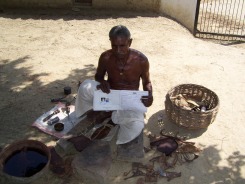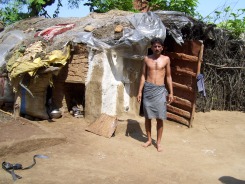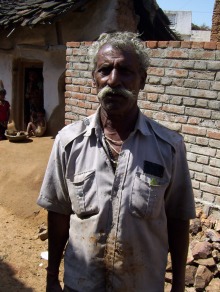Large parts of the country have had poor rainfall this year, and so the word 'drought' is on a lot of lips this these days, but in one part of India, it seems more permanent. Bundelkhand - the region of Central India between the Yamuna and the Narmada - has lived with drought for five of the last six years, the sole exception being 2008. The region's 13 districts figure in all the lists of "most backward" districts compiled by the central government. People here are reportedly the beneficiaries of various schemes for drought mitigation.
I am traveling through this region, accompanying a group that has decided to come here to get first hand accounts of how farmers are coping with the drought. As we travel, I learn the lay of the land, and its history. Bundelkhand includes almost the entire course of the rivers Betwa, Dhasan and Ken. These flow down from the Vindhyas to confluence with the Yamuna and cradle the towns of Jhansi, Chhatarpur and Sagar, the diamond mines of Panna and the fabulous temples of Khajuraho. The region is united by its language - Bundeli - and a largely shared history and culture of over 1000 years but is divided administratively between Uttar Pradesh and Madhya Pradesh.
Our first stop is Mamna village in Hamirpur district of Uttar Pradesh, a settlement of about 10,000 people. We begin talking to a couple of villagers and soon a crowd gathers around us. With no irrigation available to them, the kharif crops are a total loss, say the villagers. They are struggling even for drinking water, sometimes having to transport it from a neighboring village. Harish Kumar has had a job card (guaranteeing him a job under the National Rural Employment Guarantee Scheme) for 2 years at least. He was given some work for 1.5 months, and shows an injury sustained while working; however, he has not been paid. The date of registration on his job card has been overwritten twice to make it unclear when the card was issued. There are no work entries in the booklet.
 Small farmers in Mamna Village, Hamirpur District, UP holding their 2 year old job cards. There are no work entries in their cards.
Small farmers in Mamna Village, Hamirpur District, UP holding their 2 year old job cards. There are no work entries in their cards.
Seeing our interest in the job cards, the villagers collect over 10 job cards without any entries in a few minutes. They are all small farmers with a few bighas of land each, and willing to take up any work - but they say none is available. They show the compensation cheques they have got from the state government after the area has been declared drought affected - most are for Rs.250, less than 3 days' wages, for the loss of their kharif crop.
Some steps away, Durjan Chamar, a cobbler in his late sixties, sits forlornly with his tools outside his house waiting for customers. His daughters have married and left home, and having no sons he and his wife have to continue the struggle for a livelihood. He has the patta for three bighas of land given by the government, but as there is no water, there are no crops to be had. There are few customers for his skills in this village. He has tried to obtain work under the NREGA, but without success.
Basket weaving seems to be the sole non-farming related source of income in the village. Not just old men, even able bodied young men can be seen weaving daliyas (baskets) from dried stalks. The baskets fetch Rs.10 each and an old man we talk to says he can make only 3 baskets in a day. He receives no old age pension and is too old to take up any other work.
A large number of the small and marginal farmers have left the village in search of work. They travel to the nearby UP towns to work in brick kilns and to distant Delhi to work in the construction industry or in the factories in the NCR as unskilled labor or even driving rickshaws. We are told that a bus full of migrants from Mamna and neighboring villages has fallen into the Yamuna recently.
 Durjan Chamar, a cobbler, displays his job card which has no work entries. There is no demand in the village for his skills and no produce from his 3 bigha land.
Durjan Chamar, a cobbler, displays his job card which has no work entries. There is no demand in the village for his skills and no produce from his 3 bigha land.
On a lane leading to the center of the village, a man sits in the front room of his thatched cottage running his sewing machine. He continues to work as we sit across on a charpoy and talk. His name is Jagdish he tells us, but everyone in the village calls him Bhikari Lal, a name used by his mother to shield her only child from evil eyes.
A farmer with 2 acres, he has turned to tailoring and leased his land for a 50 per cent share of the produce. The income from the land hardly counts. He has already spent a number of years in Kandla and is back now to look after his wife and two children after his mother passed away. He could earn Rs 300 per day in Gujarat, while back in the village, he can at best earn half that amount and the payment does not come easily as the villagers do not have ready cash. He is particular about the education of his children and sends them to a private school; the quality of teaching at the government school, he says, cannot be trusted.
We come to a section of the village where the farmers with large parcels of land - 20- 25 acres - live. They have their own tube wells for irrigating their fields and use tractors. Their complaints are about the price of diesel (electricity is not available most of the time) the difficulty of getting loans for tractors, of availability of seeds and fertilizer, of how agriculture has become unviable.
The village pradhan, a woman, takes us to her house where we are treated to snacks including biscuits and cashew nuts and tea. The pradhan's husband sticks closely to us as we walk through the village. Everyone has job cards and ration cards in this village, we hear from the pradhan's husband. When we manage to lose him briefly, people tell us guardedly that they have job cards but there is no work to be had. Though the village lies by the Betwa, water is not available for irrigation as the river here flows far below the level of the fields.
Are villages in the Bundelkhand region of Madhya Pradesh doing better? We find out the next day in Ragoli in Chhatarpur District of MP. We first meet the sarpanch of this large village of about 10,000 people and, as expected, hear a lot of good news ... everyone has a job card; the poor have BPL ration cards while the rest have APL cards ...there are enough tube wells in the village for drinking water needs. The Sarpanch also has a few complaints - there is not enough work under NREGA and the government delays payments. The irrigation channel running from the village pond has not been maintained properly. Half the people in the village have migrated in search of work, he tells us.
We walk to a basti populated by the poor Raikwar community - people who traditionally work in water related occupations - to get a different picture. Swami Prasad has a job card that was made in January 2006. He has not got even a single day's work till now. But it is not Swami Prasad alone. Everyone in a group that collects around us have the same story. Job cards are there, but no jobs. Only people close to the Pradhan get work, we hear. No Panchayat Inspector or Block CEO leave alone Collector has ever visited the community, according to these residents. Some of them have been out - to Delhi, Noida and Punjab - to look for jobs and come back after working a while. After Deepawali, some of them will head out again. More than half the people from this village of 10,000 have migrated outside the state seeking work.
A government school just across from where we are standing has a board displayed that declares the menu for the mid day meal each day - the menu includes rice, different dals and green and other vegetables. According to the residents, the children only get rice gruel. The open well in the colony has not been cleaned for ages and has been rendered unfit for use. It would cost just Rs.3000-4000 to clean the well and some people would have got jobs - but this is not a priority of the panchayat. The school has its own well. Residents have to wait for the school to open to lift their water.
 Meghraj Singh in front of his hut. He has been denied a BPL card - so he can get no rations except Kerosene.
Meghraj Singh in front of his hut. He has been denied a BPL card - so he can get no rations except Kerosene.
Adhiyara, a village in Chattarpur District has over 400 families split between the communities of Thakurs, Harijans and Adivasis. There are only 5 bore wells in the village of which 2 are private and one belongs to the school and one has been set up in the Harijan basti. The lone public bore well functions only when there is power. Sometimes, the village has no power for weeks. People are forced to go to neighboring villages for water, walking 2-3 km. In summer, if there is no electricity, women sometimes stand all night in line waiting for water.
At least 100 families have migrated to Delhi, Ludhiana, Punjab and other places, we are told. People with small children migrate with their entire family leaving behind an elderly person to look after their house and cattle. Many small farmers have given their land on lease to others for a fixed sum or a share of the crop. NREGA work is available only for 10-15 people and the Panchayat President distributes it among his friends, the residents allege.
Meghraj Singh has 7 acres of land and is one of three brothers. He is not entitled to a BPL card though he lives in a crude hut. His crop has completely failed. There are two ponds near the village with rain water that is used for watering the cows - but no irrigation is available for the fields. He says farming is unviable and that there are no alternate sources of employment.
The Adivasi hamlet of 20 families is at the far end of the village. Only a few emaciated old men are to be seen around - the younger men have apparently migrated. Their condition is pathetic - no job cards or jobs, no ration cards (BPL or APL), no pension, no compensation for crops lost. There is no government intervention here where the people are most in need. The only forest product available to them is Mahua. The only work is gathering tendu leaves for the forest contractors for which they are paid based on quantity of collection.
 Nathu Singh, a farmer with 15 acres land in Adhiyara village, district Chhatarpur has only one plea - "Please tell them to solve our drinking water problem."
Nathu Singh, a farmer with 15 acres land in Adhiyara village, district Chhatarpur has only one plea - "Please tell them to solve our drinking water problem."
Paglu tells us he owns 2 acres but they are useless to him. There is no work to be had in the village even with the bigger farmers. He has worked in cities but he doesn't like it there and prefers to remain in his village. At one time, they used to hunt in the nearby forests but the government has taken away their firearm licenses.
On our way out of the village we meet Nathu Singh. He has 15 acres land. Lest we think he is prosperous, he quickly explains that he has a large family - 3 boys and 3 girls. One can see that he is but a shadow of his former proud self. He has only one plea - please, please tell the authorities to solve our drinking water problem.
All the villages we visit present the same story - complete crop failure for the small and marginal farmers who depended on the rains coupled with a lack of local employment opportunities. The much touted employment guarantee scheme of the government is not functional where it is most needed forcing large scale migration on the landless and even on small farmers. At close quarters, the picture of the panchayati raj is unedifying - viewed, as it is, as being all pervasively corrupt. The rains may have failed Bundelkhand but it is the governments of the two States, and at the Centre who have forsaken the people.























